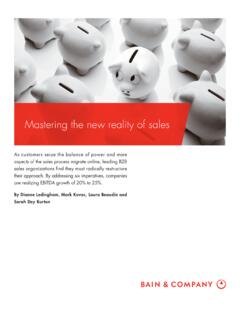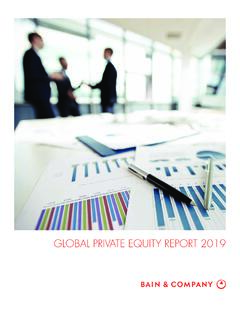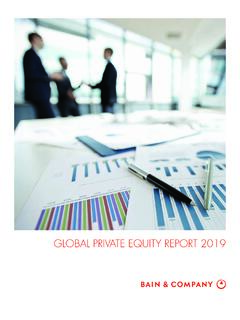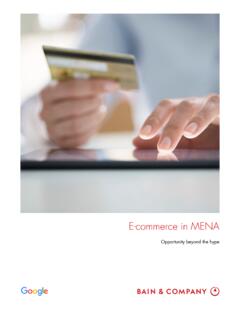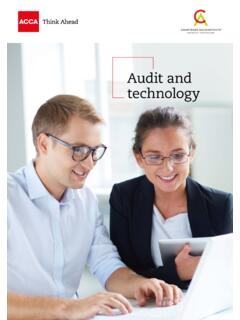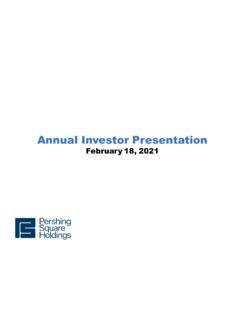Transcription of Equitable Flexibility: Reshaping our Workforce
1 Supported by ANZ, CEW thought leadership partnerEquitable Flexibility: Reshaping our WorkforceCopyright 2021 Bain & Company, Inc. All rights and acknowledgmentsBain & Company and Chief Executive Women (CEW) acknowledge the traditional owners of the lands on which we work and pay respect to Elders past, present and Gross is a partner with Bain & Company in Sydney and leads the firm s Australia Diversity, Equity & Inclusion program. Contact her at Mostyn is president of Chief Executive Women. Contact her at authors would like to recognise the following team members contributions to the report: Aaron Wilson, senior manager with Bain & Company in Sydney; Michelle Crocker, manager with Bain & Company in Sydney; Ana Rancic, associate consultant with Bain & Company in Sydney; Susan Metcalf, CEO of CEW; Pauline Vamos, non-executive director and chair of the Business Engagement Committee at CEW; Alison Aggarwal, CEW s director of policy, advocacy and research.
2 And Sarah Lai, CEW s manager of policy, advocacy and authors also wish to thank CEW members, the CEW Connect community and companies that contributed their insight and thought leadership to this report, particularly ANZ, Ashurst, Aurecon, Australia Post, Cricket Australia, Culture Amp, Dexus, Energy QLD, How Do You Do It, Gilbert + Tobin, IAG, LendLease, Merryck & Co., Mirvac, NAB, Newmont, Project F, Ramsey Health Care, Social Ventures Australia, Stockland, Unilever, and authors also wish to acknowledge and appreciate the contributions of the Champions of change Coalition, Diversity Council Australia, and the Workplace Gender Equality Flexibility: Reshaping Our WorkforceChief Executive Women | Bain & Company, from Chief Executive Women.
3 Pg. 4 Introduction ..pg. 61. How Covid-19 changed the workplace ..pg. 72. Flexibility is an economic and strategic imperative ..pg. 93. Flexibility can be a double-edged sword ..pg. 124. There are differences in Equitable flexibility ..pg. 135. Considerations and actions toward equity ..pg. 14#1: Do we set clear definitions, goals, and norms around flexibility? ..pg. 15#2: Does our culture support uptake of flexible work options by all groups? ..pg. 18#3: Do we provide employees with the right technology and training? ..pg. 20#4: Do we ensure employees have equal access for roles and opportunities? .pg. 21#5: Are leaders actively and authentically role-modelling flexibility?
4 Pg. 23 Conclusion ..pg. 25 Equitable Flexibility organisational assessment tool ..pg. 26 Our methodology ..pg. 28 References ..pg. 294 Suported byd AoeodorNZb, CEtWohgblpabsian ia2 0Eo bSA 2pro1 bsiB hb& from Chief Executive WomenThe Covid-19 pandemic has presented us with a unique, once-in-a-generation opportunity to redesign where and redefine how Australians work. As Australia embarks on the road to economic recovery, organisations across the country now have a significant opportunity to harness the full potential and talent of their Workforce in how they re-imagine the workplace. There is now an opportunity to strengthen Workforce participation and productivity to build a more resilient, dynamic and prosperous know that the pandemic has had a disproportionate impact on women and both their Workforce and their economic participation.
5 Women shouldered a higher increase in unpaid work in the household, limiting their engagement in paid work. Women were twice as likely as men to take on most of the unpaid domestic work, and more than three times as likely as men to take on caring responsibilities. Capitalising on levers that can unlock the untapped potential of women and enhance their contribution to workplaces and the economy will be key to rebuilding. The use of Equitable flexibility is one of those flexibility has in the past been seen as a women s issue , we know now it can work for businesses, for the economy, and for all employees. And when implemented equitably, it creates equal opportunity for women and men to flourish and progress in the workplace.
6 The Australian experience has demonstrated how flexibility at scale unlocks significant economic potential in the workplace. Organisations can optimise productivity and performance, while tapping into a deeper talent pool. Many employees too are reporting greater work-life balance and improved job satisfaction. As a result, and as our research with Bain & Company shows, employees want and expect to continue accessing flexible work options, including practices like flexible working hours, a condensed working week, job sharing, and working from home. Evidence suggests that organisations that have embraced Equitable flexible work arrangements retain and attract the best flexibility at work demands purposeful leadership and action to design practices that are responsive to the needs of employees and work successfully for all stakeholders.
7 Most importantly, it is critical to avoid and mitigate unintended consequences of flexibility. In order to ensure that flexibility delivers equally, careful consideration must be given to the ways in which flexibility may disadvantage those who access it. Building on our previous research, Flex for Success: Five Practices That Build a Flexible Workforce , this report goes further in advancing Equitable flexibility as a game changer for the Australian economy. This research draws on the diverse experiences of Australian companies during Covid-19 to provide an evidence base of best practices and insights for harnessing flexibility.
8 5 Suported byd AoeodorNZb, CEtWohgblpabsian ia2 0Eo bSA 2pro1 bsiB hb& , we call on organisations to embrace Equitable flexibility, that is: Practiced at scale, rather than ad-hoc; Encouraged without preconditions or judgement; Adopted by men and women at all levels of the company; and Without impediments to workplace participation, progression, learning/coaching or means creating and promoting an inclusive culture that supports men and women to balance their aspirations in work and life, offering and promoting gender- Equitable leave and working arrangements for all employees. Men and women need to have equal access to and uptake in working flexibly, without negative judgments or repercussions for career progression.
9 Only when the playing field levels will all employees have equal opportunities to advance leaders and organisations are purposeful in how they build dynamic workplaces, we have the opportunity to realise the potential of our highly educated and talented Workforce , and in turn maximise participation in and contribution to our economy. Companies have an opportunity to reset culture and accelerate expectations and policies surrounding flexible work. As we come out of the pandemic, how we choose to work will influence our productivity and performance as an the backdrop of a highly uncertain global economic environment, we need to draw on all the talent and investment in both women and men to reinvigorate our economy.
10 This is our catalyst to create powerful, lasting change . A joint effort from our business and civic leaders can deliver this vision of Equitable flexibility and create a more prosperous economy for Mostyn President, Chief Executive Women6 Suported byd AoeodorNZb, CEtWohgblpabsian ia2 0Eo bSA 2pro1 bsiB hb& World Economic Forum (WEF) Global Gender Gap Index benchmarks global companies and their gender performance against four key dimensions: economic participation and opportunity, educational attainment, health and survival, and political empowerment. In the 2021 rankings, Australia slipped in every major dimension but one: the educational attainment of women.
